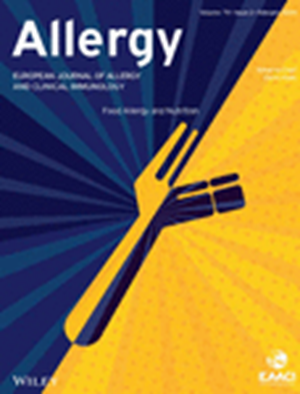治疗特应性皮炎的生物制剂:有效性、安全性和未来方向。
IF 12
1区 医学
Q1 ALLERGY
引用次数: 0
摘要
特应性皮炎(AD)是世界上最常见的慢性炎症性皮肤病之一。阿尔茨海默病的临床表现是异质性的,其特点是复发和缓解过程。大多数患者患有轻度阿尔茨海默病,而大约5%至20%的患者患有严重的疾病活动,这通常需要全身治疗。在2017年之前,全身治疗选择仅限于广泛的免疫抑制剂,这些药物通常具有显着的毒性和有限的有效性。对阿尔茨海默病病理生理学的理解的进步导致了靶向生物治疗的发展,包括dupilumab, tralokinumab, lebrikizumab和nemolizumab。这些单克隆抗体特异性阻断AD相关的关键促炎细胞因子,改善疾病控制和症状缓解。Dupilumab是首个获批的生物制剂,可抑制IL-4和IL-13信号传导,而tralokinumab和lebrikizumab可选择性阻断IL-13。Nemolizumab靶向IL-31, IL-31在瘙痒中起着至关重要的作用。本综述主要总结了这些生物制剂的有效性和安全性的真实数据,为其使用和副作用管理提供临床指导。它还简要讨论了目前处于3期试验的有希望的治疗靶点。本文章由计算机程序翻译,如有差异,请以英文原文为准。
Biologics to Treat Atopic Dermatitis: Effectiveness, Safety, and Future Directions.
Atopic dermatitis (AD) is one of the most common chronic inflammatory skin diseases worldwide. The clinical presentation of AD is heterogeneous and is characterized by a relapsing and remitting course. Most patients suffer from mild AD while approximately 5% to 20% experience severe disease activity, which often requires systemic treatment. Before 2017, systemic treatment options were limited to broad immunosuppressants, which often had significant toxicity and limited effectiveness. Advances in understanding AD pathophysiology have led to the development of targeted biologic therapies, including dupilumab, tralokinumab, lebrikizumab, and nemolizumab. These monoclonal antibodies specifically block key pro-inflammatory cytokines involved in AD, improving disease control and symptom relief. Dupilumab, the first approved biologic, inhibits IL-4 and IL-13 signaling, while tralokinumab and lebrikizumab selectively block IL-13. Nemolizumab targets IL-31, which plays a crucial role in pruritus. This review summarizes primarily real-world data on the effectiveness and safety of these biologics, providing clinical guidance for their use and management of side effects. It also briefly discusses promising therapeutic targets currently in phase 3 trials.
求助全文
通过发布文献求助,成功后即可免费获取论文全文。
去求助
来源期刊

Allergy
医学-过敏
CiteScore
26.10
自引率
9.70%
发文量
393
审稿时长
2 months
期刊介绍:
Allergy is an international and multidisciplinary journal that aims to advance, impact, and communicate all aspects of the discipline of Allergy/Immunology. It publishes original articles, reviews, position papers, guidelines, editorials, news and commentaries, letters to the editors, and correspondences. The journal accepts articles based on their scientific merit and quality.
Allergy seeks to maintain contact between basic and clinical Allergy/Immunology and encourages contributions from contributors and readers from all countries. In addition to its publication, Allergy also provides abstracting and indexing information. Some of the databases that include Allergy abstracts are Abstracts on Hygiene & Communicable Disease, Academic Search Alumni Edition, AgBiotech News & Information, AGRICOLA Database, Biological Abstracts, PubMed Dietary Supplement Subset, and Global Health, among others.
 求助内容:
求助内容: 应助结果提醒方式:
应助结果提醒方式:


